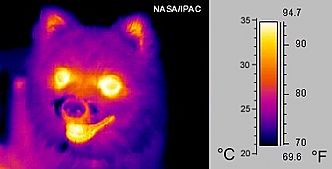Infrared facts for kids

Infrared (IR) radiation is a special type of electromagnetic radiation. Think of it as a wave that carries energy, like light or radio waves.
It's part of the electromagnetic spectrum, which includes all kinds of waves. Infrared waves are longer than the light we can see (like red light) but shorter than microwaves.
The name infrared means below red. This is because red light has the longest wavelength that human eyes can see. Infrared waves have even longer wavelengths, so we can't see them.
Even though we can't see infrared, we can feel it! Our bodies sense infrared radiation as heat. That's why you feel warm when you stand in the sun, even if you can't see the infrared rays.
Many everyday things use infrared. For example, most remote controls use infrared signals to change channels on your TV. Also, some missiles use infrared to find their targets by sensing the heat they give off.
How We Use Infrared
Infrared technology is used in many cool ways. You might not even realize how often you interact with it!
Remote Controls
Before Bluetooth became popular, some computers, personal digital assistants (PDAs), and mobile phones used infrared. They sent files to other devices using infrared signals.
Bluetooth took over in the early 2000s. One reason was that infrared needs a "line of sight." This means the two devices have to be pointed directly at each other to send information.
Fiber Optics
Infrared lasers are very important for optical fiber communication. These systems send information using light through tiny glass fibers.
Infrared light is used because it travels well through these fibers. This allows for fast internet and phone connections over long distances.
Images for kids
-
A pseudocolor image of two people taken in long-wavelength infrared (body-temperature thermal) radiation.
-
This false-color infrared space telescope image has blue, green and red corresponding to 3.4, 4.6, and 12 μm wavelengths, respectively.
-
Materials with higher emissivity appear closer to their true temperature than materials that reflect more of their different-temperature surroundings. In this thermal image, the more reflective ceramic cylinder, reflecting the cooler surroundings, appears to be colder than its cubic container (made of more emissive silicon carbide), while in fact, they have the same temperature.
-
Hyperspectral thermal infrared emission measurement, an outdoor scan in winter conditions, ambient temperature −15 °C, image produced with a Specim LWIR hyperspectral imager. Relative radiance spectra from various targets in the image are shown with arrows. The infrared spectra of the different objects such as the watch clasp have clearly distinctive characteristics. The contrast level indicates the temperature of the object.
-
Infrared light from the LED of a remote control as recorded by a digital camera
-
Infrared hair dryer for hair salons, c. 2010s
-
IR satellite picture of cumulonimbus clouds over the Great Plains of the United States.
See also
 In Spanish: Radiación infrarroja para niños
In Spanish: Radiación infrarroja para niños












